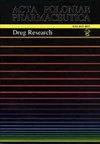丙戊酸和2-丙基-4-戊酸对急性和慢性暴露中GSH/GSSG比值和FRAP水平测定的抗氧化状态的影响
IF 0.4
4区 医学
Q4 PHARMACOLOGY & PHARMACY
引用次数: 0
摘要
丙戊酸(VPA)是一种广谱抗惊厥药物。其作用机制包括增强GABA能传递、阻断电压门控钠通道以及影响多巴胺能和5-羟色胺能传递(1)。VPA毒性的机制,包括其对肝脏的影响,尚不完全清楚。据推测,氧化应激和/或药物生物转化的反应产物是其肝毒性的原因(2)。本研究的目的是验证丙戊酸及其代谢产物2-丙基-4-戊烯酸(4-en-VPA)对接受(VPA-T)治疗和丙戊酸(VPA-P)中毒患者抗氧化状态影响的假设。VPA-P组被分为在住院期间观察到的有(VPA-Ptox)和没有(VPA-Pnon)毒性症状的患者。使用抗氧化电位(FRAP)等标志物评估氧化应激,并测量研究患者血浆中还原和氧化谷胱甘肽(GSH/GSSG)的比率。所获得的结果显示,在VPA-T和VPA-P组中,药物浓度及其活性代谢产物水平之间存在统计学上的显著差异。在VPA-P组中,血浆中4-en-VPA水平的增加与药物浓度的增加相关。VPA对两组患者抗氧化平衡的影响已得到证实。在VPA-Ptox组中,FRAP的血浆抗氧化潜力随着丙戊酸浓度的增加而降低。VPA-Pnon组GSH/GSSG比值最低,住院期间无中毒症状。本文章由计算机程序翻译,如有差异,请以英文原文为准。
The impact of valproic acid and 2-propyl-4-pentenoic acid on antioxidant status measured by GSH/GSSG ratio and FRAP levels in acute and chronic exposure
Valproic acid (VPA) is a broad-spectrum anticonvulsant drug. Its mechanism of action includes enhancing GABAergic transmission, blocking voltage-gated sodium channels, and affecting dopaminergic and serotonergic transmission (1). The mechanism of VPA toxicity, including its effects on the liver, is not fully known. It is assumed that oxidative stress and/or reactive products of drug biotransformation are responsible for its hepatotoxicity (2). The aim of the study was to verify the hypothesis concerning the influence of valproic acid and its metabolite, 2-propyl-4-pentenoic acid (4-en VPA) on the antioxidant status of patients treated with (VPA-T) and poisoned with valproic acid (VPA-P). The VPA-P group was divided into patients with (VPA-Ptox) and without (VPA-Pnon) toxic symptoms observed during the hospitalization. Oxidative stress was assessed using markers, such as antioxidant potential (FRAP) and reduced and oxidised glutathione (GSH/GSSG) ratio were measured in the plasma of the study patients. The obtained results showed statistically significant differences between the concentrations of the drug and its active metabolite levels in the VPA-T and VPA-P groups. In the VPA-P group, the increase of the level of 4-en VPA in the plasma correlated with the increase of the concentration of the drug. The influence of VPA on the antioxidant balance in both groups of patients was demonstrated. The plasma antioxidant potential of FRAP decreased with increasing valproic acid concentrations in the VPA-Ptox group. The lowest concentrations of GSH/GSSG ratio were found in the VPA-Pnon group, without symptoms of intoxication during hospitalization.
求助全文
通过发布文献求助,成功后即可免费获取论文全文。
去求助
来源期刊
CiteScore
0.80
自引率
0.00%
发文量
74
审稿时长
6-12 weeks
期刊介绍:
The international journal of the Polish Pharmaceutical Society is published in 6 issues a year. The journal offers Open Access publication of original research papers, short communications and reviews written in English, in all areas of pharmaceutical sciences. The following areas of pharmaceutical sciences are covered: Analysis, Biopharmacy, Drug Biochemistry, Drug Synthesis, Natural Drugs, Pharmaceutical Technology, Pharmacology and General.
A bimonthly appearing in English since 1994, which continues “Acta Poloniae Pharmaceutica”, whose first issue appeared in December 1937. The war halted the activity of the journal’s creators. Issuance of “Acta Poloniae Pharmaceutica” was resumed in 1947. From 1947 the journal appeared irregularly, initially as a quarterly, then a bimonthly. In the years 1963 – 1973 alongside the Polish version appeared the English edition of the journal. Starting from 1974 only works in English are published in the journal. Since 1995 the journal has been appearing very regularly in two-month intervals (six books a year). The journal publishes original works from all fields of pharmacy, summaries of postdoctoral dissertations and laboratory notes.

 求助内容:
求助内容: 应助结果提醒方式:
应助结果提醒方式:


